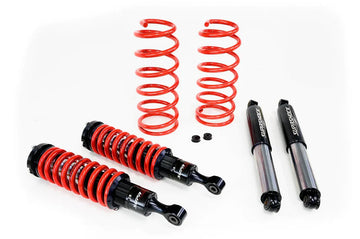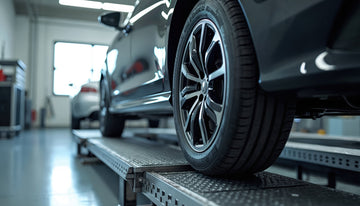Properly installing coilovers into your car is important if you want to achieve optimal suspension performance, handling, and safety. In this article, we will delve into the importance of correct coilover installation and provide a detailed guide on how to install coilovers step by step.
What are the steps for coilover installation?
Coilover installation involves several steps to ensure proper fitment, alignment, and functionality. Here are the general steps for installing coilovers on a vehicle:
1. Prepare the vehicle
Ensure that the vehicle is parked on a level surface and that the parking brake is engaged for added safety. Use jack stands to securely lift the vehicle off the ground, providing ample space to work underneath.
2. Remove the wheels
With the vehicle elevated, proceed to remove the wheels by first loosening the lug nuts. Once the lug nuts are loosened, remove the wheels entirely to gain access to the suspension components.
3. Remove the old suspension
Start by disconnecting any components attached to the suspension, such as sway bars, brake lines, and ABS sensors. Unbolt and remove the old shocks, springs, and struts from the vehicle, taking care to keep track of any hardware or fasteners for reassembly later.
4. Install coilovers
Begin by assembling the coilovers according to the manufacturer's instructions, which may include adjusting ride height and damping settings if applicable. Install the coilovers into the designated mounting points on the vehicle, ensuring proper alignment and fitment. Secure the coilovers using the provided hardware and torque to manufacturer specifications for a secure and stable installation.
5. Connect components
Reconnect any components that were disconnected during the old suspension removal, such as sway bars, brake lines, and ABS sensors. Double-check all connections to ensure everything is properly secured and in place.
6. Adjust settings
After the coilovers are installed and components are connected, it's important to adjust the settings accordingly. This includes adjusting ride height and preload settings on the coilovers as needed, following the manufacturer's guidelines and recommendations. If the coilovers are adjustable, set damping settings considering factors like driving style, road conditions, and desired performance.
7. Check alignment and test drive
Once adjustments are made, lower the vehicle back to the ground and test the suspension by bouncing each corner to check for proper function and clearance.
8. Final checks
Finally, conduct a thorough final inspection, double-checking all connections, hardware, and adjustments for tightness and correctness. Reinstall the wheels and torque the lug nuts to specification. Perform a test drive to assess ride quality, handling, and any potential issues that may arise.
Should I install my coilovers myself, or get them professionally fitted?
Whether you should install coilovers yourself or opt for professional fitting depends on several factors, including the following:
-
Mechanical Skills: If you have experience with automotive repairs and are comfortable working with suspension components, you may feel confident enough to install coilovers yourself. However, if you're relatively inexperienced or unsure about handling such tasks, professional fitting can ensure a proper and safe installation.
-
Tools and Equipment: Installing coilovers typically requires specific tools such as jack stands, torque wrenches, spring compressors, and alignment tools. Ensure you have access to these tools and are familiar with their usage before attempting a DIY installation. Professional installers have access to specialized equipment and tools, making the fitting process more efficient and accurate.
-
Manufacturer's Instructions: Follow the manufacturer's instructions carefully when installing coilovers. Some coilovers come with detailed installation guides, while others may require adjustments or modifications based on your vehicle's specifications. If you're unsure about any step or adjustment, seeking professional assistance can ensure correct installation.
-
Warranty Considerations: Check the warranty terms provided by the coilover manufacturer. DIY installation may void the warranty if not done correctly, while professional installation by authorised technicians often comes with warranty coverage for the parts and labor.
-
Safety: Suspension components play a critical role in vehicle safety and performance. Improperly installed coilovers can affect handling, stability, and braking, leading to safety hazards. If you're not confident in your abilities to install coilovers correctly, it's advisable to seek professional fitting to ensure safety on the road.
What are the signs that I’ve installed my coilovers incorrectly?
Improperly installed coilovers can lead to various signs and symptoms that indicate something is amiss with the suspension system. Here are some common signs that you may have installed your coilovers incorrectly:
-
Uneven Ride Height: An uneven ride height post-coilover installation hints at misalignment or incorrect adjustments.
-
Excessive Bouncing: Improperly installed coilovers can cause a bouncy ride over bumps, indicating damping or preload issues.
-
Unusual Noise: Clunking sounds from the suspension suggest loose components due to faulty coilover installation.
-
Poor Handling: Incorrectly installed coilovers can lead to increased body roll and reduced steering response.
-
Excessive Tire Wear: Misaligned coilovers may result in abnormal tire wear patterns and handling problems.
-
Leaking Fluid: Fluid leaks from dampers indicate compromised shock absorber integrity from improper installation.
-
Vehicle Pulling: Drifting on straight roads could be caused by alignment issues due to incorrect coilover setup.
- Warning Lights: ESC-equipped vehicles may display warning lights for suspension faults related to the coils or other components.
If you notice any of these signs after installing coilovers, it's crucial to address the issues promptly. Consult the manufacturer's instructions for troubleshooting guidance, consider seeking professional assistance for diagnosis and correction, and avoid driving the vehicle until the suspension issues are resolved to ensure safety and optimal performance.





